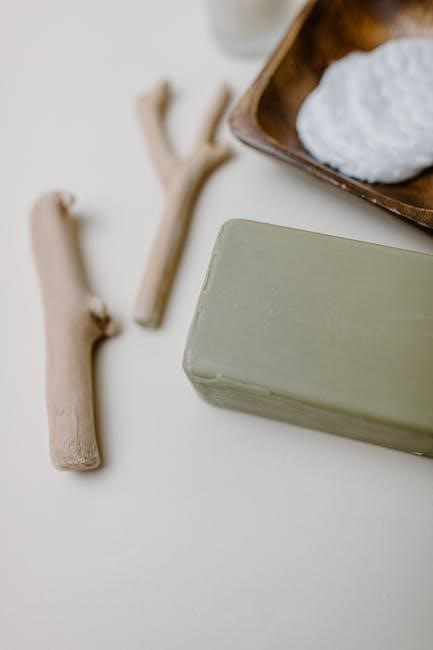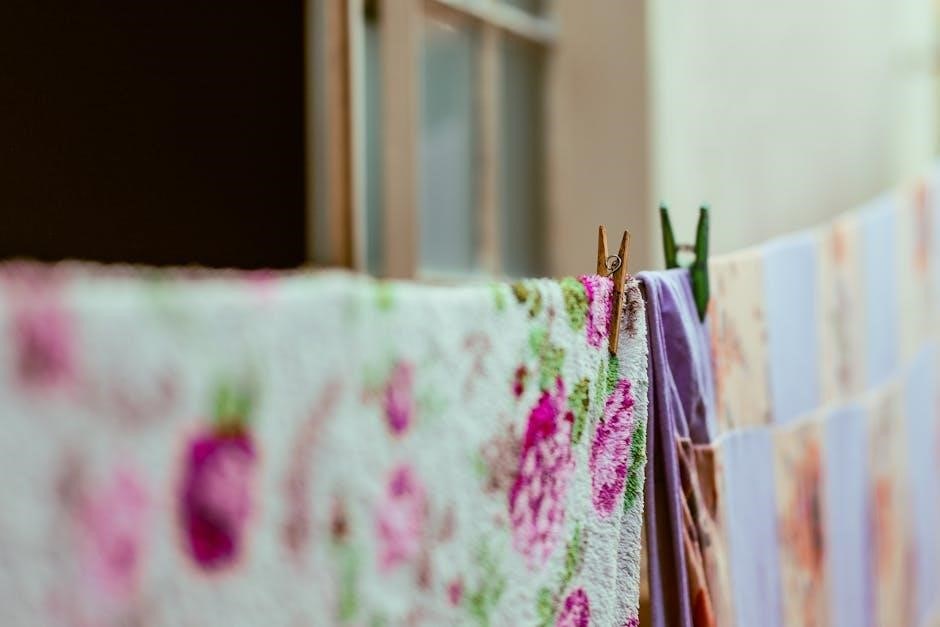
Washing 100% cotton fabrics requires attention to maintain softness and durability. Key factors include temperature, machine or hand washing, and potential shrinkage. Always follow care labels for best results.
Understanding the Fabric Care Label
Always check the fabric care label for specific washing instructions, as it provides crucial guidance tailored to the garment. Symbols indicate preferred washing methods, water temperatures, and drying options. Ignoring these labels can lead to shrinkage, color fading, or fabric damage; The label may advise hand washing, machine washing on a gentle cycle, or specific temperature settings. Adhering to these guidelines ensures the longevity and quality of your 100% cotton items.

Benefits of Washing 100% Cotton Fabrics
Washing 100% cotton fabrics helps maintain their softness, breathability, and durability. Regular washing removes dirt and odors, ensuring hygiene and comfort. Proper care preserves the fabric’s natural qualities.
Why 100% Cotton Requires Specific Care
100% cotton fabrics need special attention due to their natural fibers, which can shrink or lose softness if not washed properly. Cotton fibers tighten when exposed to heat, leading to shrinkage. Using the right temperature and detergent helps preserve softness and durability. Improper washing can cause stiffness or damage, emphasizing the need for gentle care to maintain the fabric’s breathability and comfort over time.

Washing Machine vs. Hand Washing: Which is Better?
Machine washing is efficient but may cause wear, while hand washing preserves fabric quality. Choose based on fabric delicacy and care label recommendations for best results.
Pros and Cons of Machine Washing
Machine washing is efficient and convenient, ideal for heavily soiled 100% cotton fabrics. It saves time and effort compared to hand washing. However, it can cause wear and tear, especially if settings are too harsh. High-spin cycles may lead to shrinkage or fabric distortion. Proper settings and gentle cycles can mitigate these issues, making machine washing a practical choice for everyday cotton care while balancing fabric preservation.
When to Opt for Hand Washing
Hand washing is ideal for delicate or special-care 100% cotton items, such as lingerie, embroidery, or vintage fabrics. It ensures gentle treatment, preserving fabric integrity and preventing shrinkage. For heavily soiled cotton, hand washing can be time-consuming but effective. Always use cold water and mild detergents to avoid damage. This method is also recommended for items with plastic buttons or decorative elements that may not withstand machine washing. Follow care labels for best results.

Temperature Guidelines for Washing Cotton
Cold water preserves color and texture, while hot water removes tough stains. Generally, low to medium temperatures are recommended for 100% cotton to prevent shrinkage and damage.
Cold Water vs. Hot Water: What’s Best for Cotton
Choosing the right water temperature is crucial for washing 100% cotton. Cold water helps preserve color, texture, and elasticity, making it ideal for vibrant or delicate fabrics. Hot water, while effective at removing tough stains, can cause shrinkage and weaken fibers over time. For most cotton items, a low to medium temperature, such as 30°C to 40°C, strikes a balance between cleaning power and fabric protection. Always check the care label for specific recommendations.
Recommended Temperature Range for Cotton Fabrics
The ideal temperature for washing 100% cotton fabrics typically ranges between 30°C and 40°C. This range ensures effective cleaning while preserving the fabric’s softness and color. For heavily soiled items, a slightly higher temperature, up to 60°C, may be used, but avoid extreme heat to prevent shrinkage. Delicate or brightly colored cotton should be washed in cold water to maintain texture and vibrancy. Always refer to the fabric care label for specific temperature guidelines.

Detergent Choices for 100% Cotton
For 100% cotton, choose a mild detergent to prevent damage. Conventional detergents effectively remove dirt, while natural or eco-friendly options are gentler on fabrics and the environment.
Natural vs. Conventional Detergents: Which is More Effective
Natural detergents are gentler on 100% cotton fabrics and the environment, reducing residue buildup. Conventional detergents, while effective at removing tough stains, may contain harsh chemicals that could damage fibers over time. For eco-conscious users, natural options are ideal, but conventional detergents offer better stain removal power. Choosing the right one depends on fabric sensitivity, stain type, and personal preference for sustainability or cleaning strength.
Pre-Treatment of Stains Before Washing
Pre-treating stains on 100% cotton is crucial for effective removal. Apply a small amount of detergent or stain remover directly to the stain. Gently rub or blot the area to work the product in. For tough stains, let it sit for 10–15 minutes before washing. Cold water prevents stains from setting, while hot water may fix them permanently. Avoid harsh scrubbing, as it can damage fibers. This step ensures better cleaning results in the wash cycle.

Drying Instructions for 100% Cotton
Air drying is recommended for 100% cotton to preserve softness and prevent shrinkage. Lay flat or hang to dry away from direct sunlight. For machine drying, use low heat and remove promptly to maintain fabric quality and shape.
Air Drying vs. Machine Drying: Preserving Fabric Quality
Air drying is ideal for preserving the softness and texture of 100% cotton fabrics, as it prevents shrinkage and maintains breathability. Lay clothes flat or hang them in a shaded area to avoid direct sunlight, which can cause fading. Machine drying is quicker but should be done on a low heat setting to minimize damage. Remove promptly to avoid wrinkles and fabric stress. Air drying is gentler, while machine drying on low heat is a practical alternative.
Tumble Drying on Low Heat: Tips and Precautions
Tumble drying 100% cotton on low heat minimizes shrinkage and fabric wear. Remove clothes as soon as the cycle ends to prevent wrinkles and creases. Avoid overdrying, as it can stiffen the fabric; Use a clean dryer lint filter to improve airflow and reduce drying time. Never leave cotton fabrics in the dryer for extended periods, as heat can weaken fibers. Always opt for the gentlest setting to preserve softness and longevity.

Common Mistakes to Avoid When Washing Cotton
Overloading the washing machine, using hot water, and ignoring fabric care labels can damage cotton fabrics. Avoid excessive detergent and harsh chemicals to maintain softness and durability.
Overloading the Washing Machine: Why It’s a Bad Idea
Overloading the washing machine can lead to poor washing results, fabric damage, and increased wear on clothes. It prevents proper water circulation, causing fibers to rub excessively, leading to shrinkage and weakening of cotton fabrics. This also increases the risk of snagging and pilling. To maintain fabric quality, it’s essential to wash cotton items in moderately sized loads, ensuring enough space for movement during cycles. This prevents unnecessary stress on the fabric and extends its lifespan.
The Risks of Using Excessive Detergent
Using too much detergent can harm 100% cotton fabrics by leaving residue that stiffens the material and reduces softness. It can also clog washing machine components and affect rinse efficiency. Excess detergent may cause skin irritation for wearers and create excessive foam that strains the machine. Additionally, it can lead to premature wear and tear on fabrics. Always use the recommended amount to maintain fabric quality and ensure proper cleaning without damage.
Removing Tough Stains from Cotton Fabrics
Tough stains on 100% cotton can be tackled with pre-treatment and soaking. Apply detergent or stain remover directly to the stain before washing for best results.
Effective Methods for Stubborn Stain Removal
For stubborn stains on 100% cotton, start by assessing the type of stain. Pre-treat with a mild detergent or stain remover, gently rubbing the fabric. Soak the garment in cold water with detergent for several hours. For tough stains, apply white vinegar or baking soda paste directly. Enzyme-based cleaners work well for protein-based stains like blood. Avoid hot water initially, as it can set the stain. Spot clean and rinse thoroughly before washing. Repeat if needed for complete removal.
Pre-Washing and Shrinking: What You Need to Know
Pre-washing 100% cotton fabrics helps prevent shrinkage and sets colors. Wash in cold water using a gentle cycle to minimize shrinkage; Avoid hot water and aggressive washing, as they can damage fibers and cause significant shrinking. This step ensures your cotton items retain their size and quality after washing.
Should You Pre-Wash 100% Cotton Fabrics?
Pre-washing 100% cotton fabrics is advisable to manage shrinkage and set colors. It ensures dimensional stability and prevents unexpected changes post-project completion. Washing in cold water with mild detergent helps maintain fabric integrity, while air-drying preserves softness and texture. Pre-washing is particularly beneficial for garments requiring precise fit and color retention, though it may not be essential for all projects. Balancing effort and benefits helps determine its necessity.
Understanding Shrinkage in Cotton Fabrics
Cotton fabrics can shrink due to the natural fibers contracting when exposed to heat or aggressive washing. Shrinkage is most noticeable after the first wash, as the weaving process leaves fibers under tension. Using cold water and gentle cycles minimizes this effect. Air-drying instead of machine drying further reduces shrinkage risk. Pre-washing helps stabilize the fabric, ensuring a consistent fit and appearance over time. Proper care preserves the fabric’s integrity and prevents excessive shrinkage.

Fabric Softeners and Cotton: To Use or Not to Use
Fabric softeners reduce static cling but may leave a residue on cotton, affecting breathability. For 100% cotton, they’re optional; natural softness often makes them unnecessary. Vinegar rinse is a natural alternative.
The Impact of Fabric Softeners on Cotton
Fabric softeners reduce static cling and leave a soft finish but may coat cotton fibers, reducing breathability. Overuse can lead to residue buildup, affecting absorbency. Natural alternatives like vinegar rinses maintain softness without chemicals, preserving cotton’s natural texture and performance. Balancing softness and fabric health is key when choosing additives for washing 100% cotton fabrics.
Bleach and Cotton: Safe or Not?
Bleach can be used on cotton but cautiously. Chlorine bleach may weaken fibers or cause yellowing, while oxygen bleach is safer for colors. Always spot-test first.
When and How to Use Bleach on Cotton Fabrics
Use bleach on cotton sparingly, as it can weaken fibers. Chlorine bleach is suitable for whites but avoid it for colored fabrics. Oxygen bleach is safer for colors. Always spot-test first, dilute bleach in water, and avoid frequent use to prevent damage. For tough stains, apply directly but rinse thoroughly to remove residue. Never mix bleach with other cleaners to avoid harmful reactions.